Quick Answer
To dress like Aristotle Onassis, wear navy blue or charcoal grey tailored double-breasted suits with white shirts with open collars. For casual settings, wear white linen trousers and neutral-toned polo shirts. Complete both looks with accessories like thick-framed sunglasses, luxury watches, and fine leather old money style shoes. The key is to emphasise quality and understated elegance over flashy displays of wealth.
Key Points to Remember
- Favour Caraceni-style suits with wide peaked lapels and a slightly longer jacket cut
- Stick to a refined colour palette: navy blue for suits, white for shirts, and neutral tones for casual wear
- Invest in quality accessories: François Pinton-style sunglasses, Patek Philippe or Omega watches, and John Lobb shoes
- Maintain consistency in style across both formal and casual settings
Want to learn more? Continue reading the full article below ↓
Onassis’s Style Journey from Rags to Riches
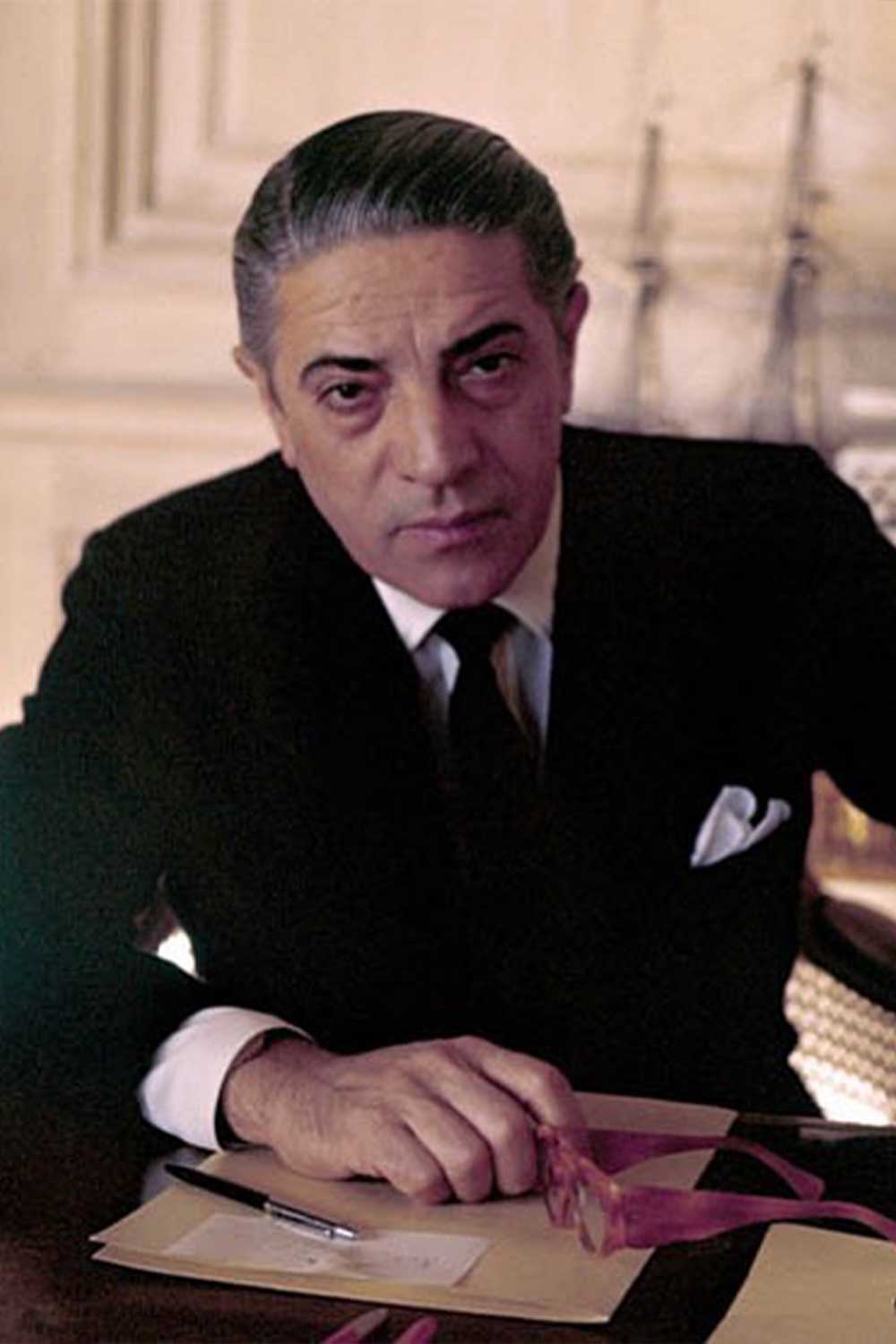
Aristotle Onassis stands unrivalled in the pantheon of 20th-century style icons as the Greek shipping tycoon of masculine elegance, setting the gold standard for men of wealth and power.
And, for stylish modern men who seek to embody true aristocratic refinement and old-money elegance, studying Onassis and his unique wardrobe is paramount.
Born in 1906 in Smyrna (now Izmir, Turkey), Onassis’s early life was far removed from the luxury he would later embody.
Although his father, Socrates Onassis, was a successful shipping entrepreneur who managed to send his children to prestigious schools, Turkish forces’ 1922 takeover of Smyrna saw the Onassis family lose everything, fleeing with only the clothes on their backs.
This experience instilled in young Aristotle a burning desire for security and success, later reflected in his love for imposing double-breasted suits that acted as a status symbol and emotional armour.
Early Business Ventures
Arriving penniless in Buenos Aires, Onassis worked as a telephone operator by night and frequented upscale venues daily.
During this period, he began to understand the power of appearance in opening doors.
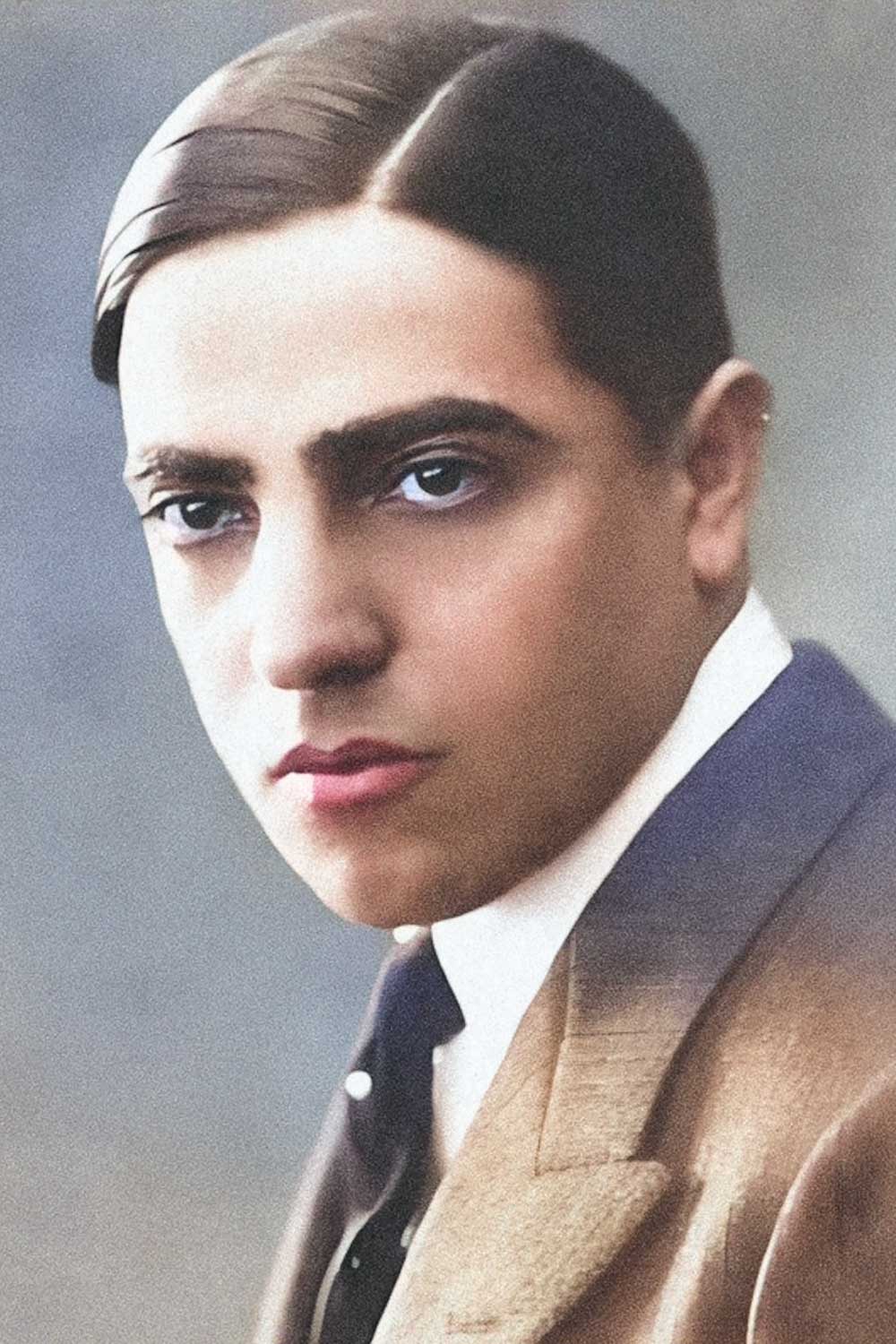
He invested in his first tailored suit, recognising it as a crucial tool for gaining entry into influential circles.
This early lesson in dressing for success would stay with him throughout his life.
The Tobacco Deal
Onassis’s first significant business coup came with his tobacco import deal.
To negotiate with Greek tobacco growers, he dressed in a manner that projected confidence and wealth beyond his means.
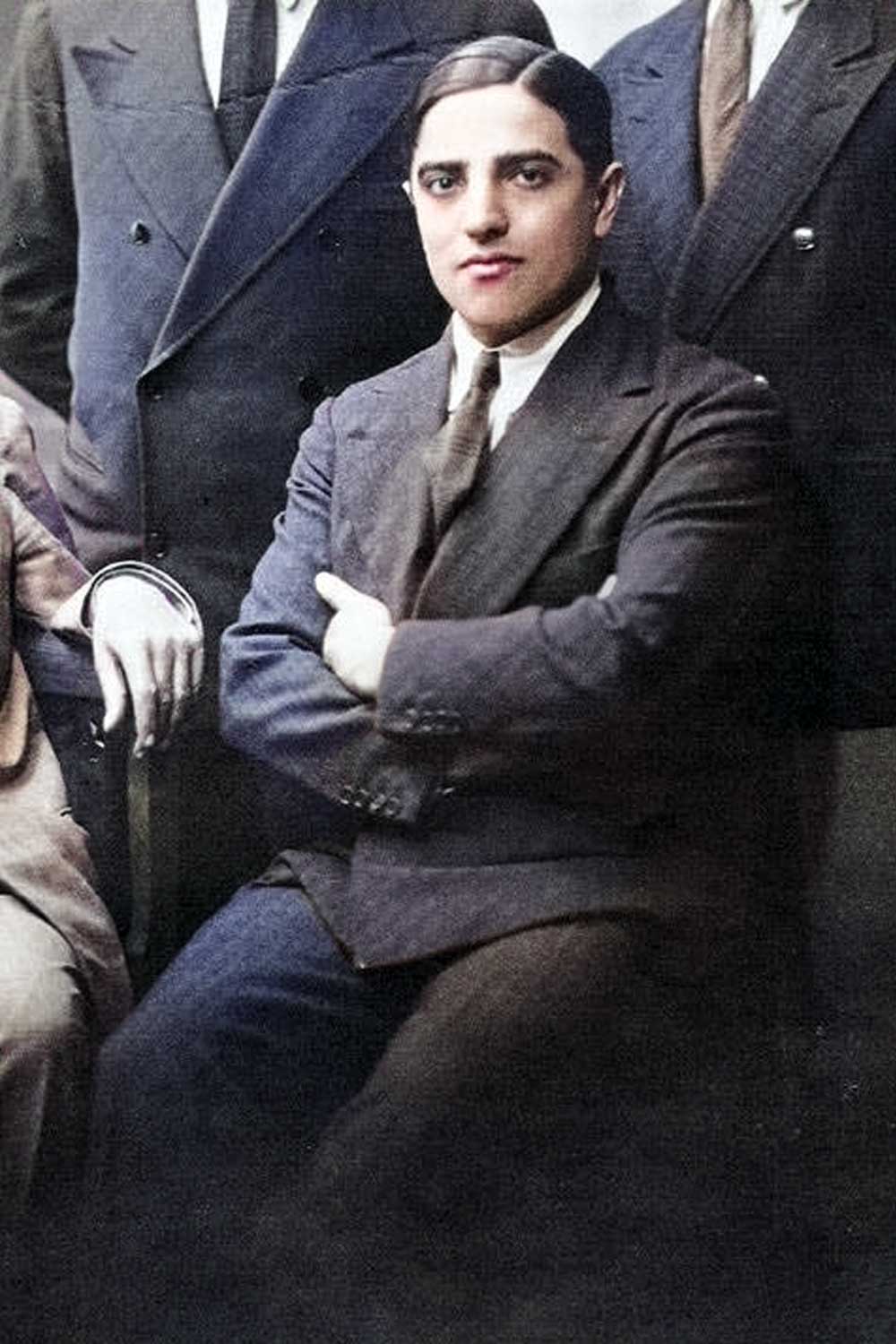
His choice of a well-cut suit, crisp white shirt, and polished shoes helped him secure the trust needed to broker the deal to make his first million by age 25.
Entering the Shipping World
As Onassis entered the shipping industry in the 1930s, his style evolved to match his new status.
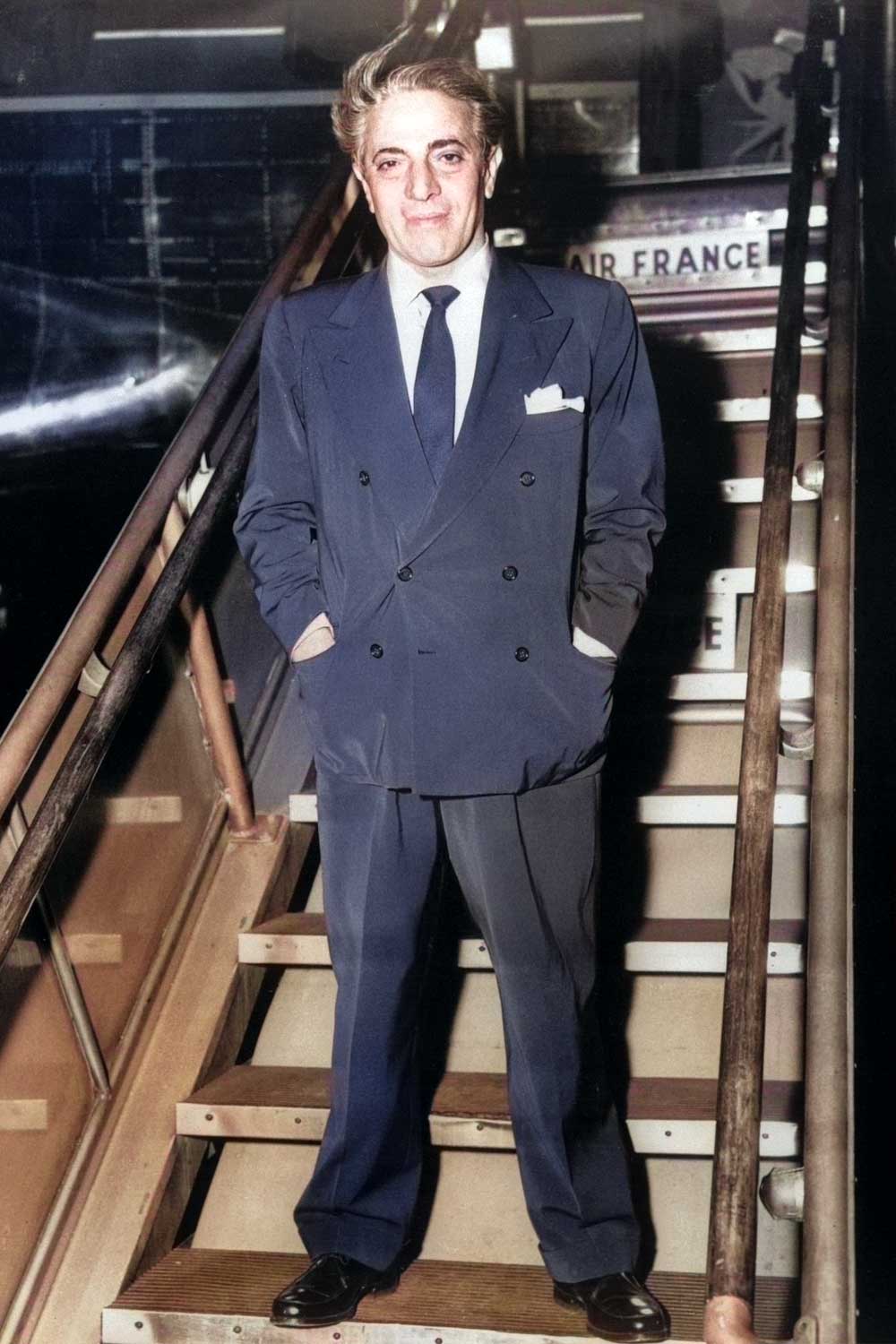
He began to favour British tailoring, often seen in Savile Row suits that spoke of old-world craftsmanship.
His move to New York saw him incorporate elements of American preppy style, such as the occasional button-down Oxford shirt, while retaining his European flair.
The Pinnacle of Success
By the 1950s, with his shipping empire firmly established, Onassis had honed his signature style.
His patronage of Caraceni in Milan for his suits, Turnbull & Asser for shirts, and John Lobb for shoes reflected his wealth, discerning taste, and appreciation for the finest craftsmanship.
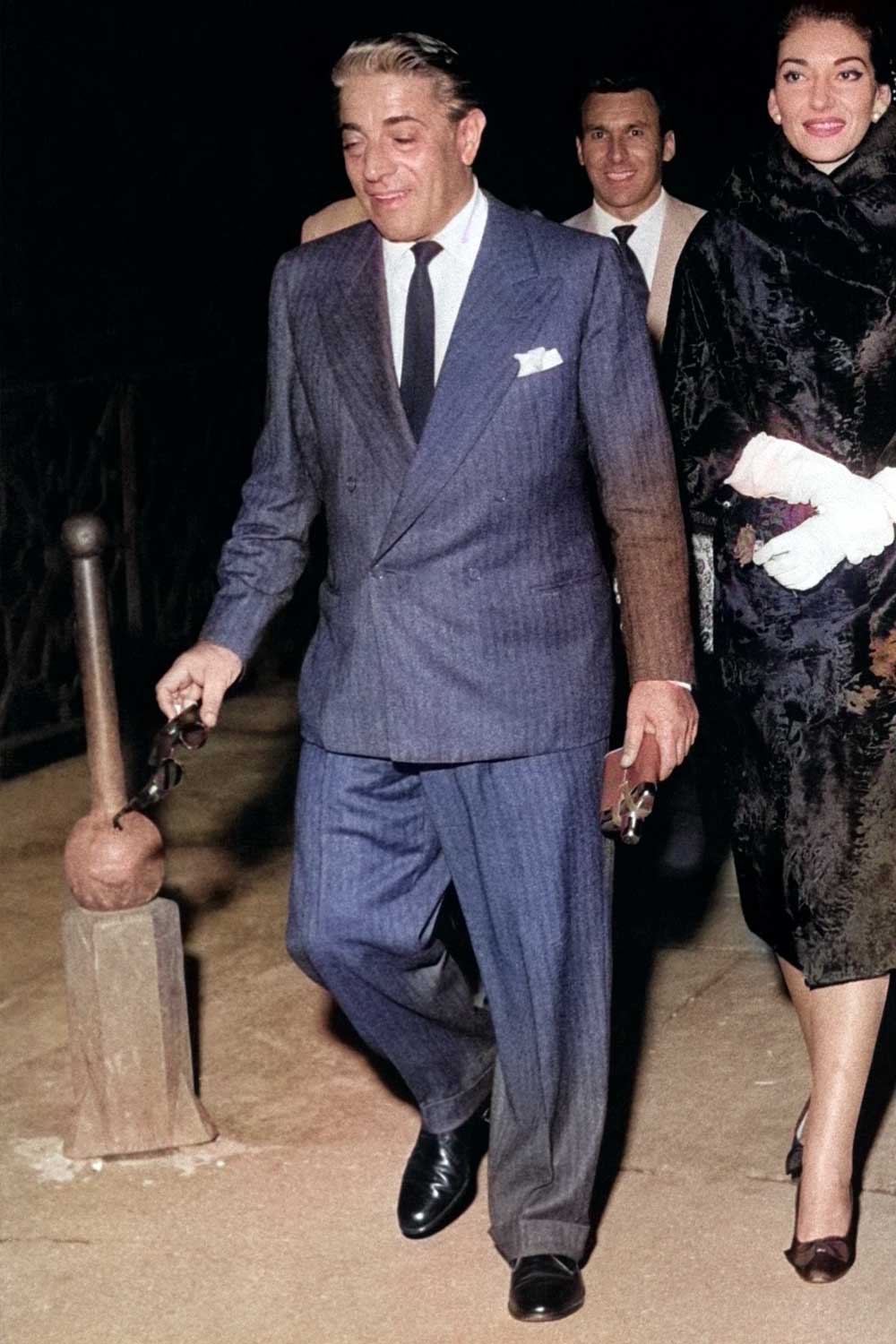
The consistency of his look – the navy suits, the open-necked white shirts, the ever-present sunglasses – became a personal brand as recognisable as his business achievements.
Onassis’s journey from refugee to tycoon is reflected in every aspect of his iconic style.
His clothing choices were not mere vanity but a carefully constructed image of resilience, ambition, and ultimate triumph.
The Onassis Wardrobe
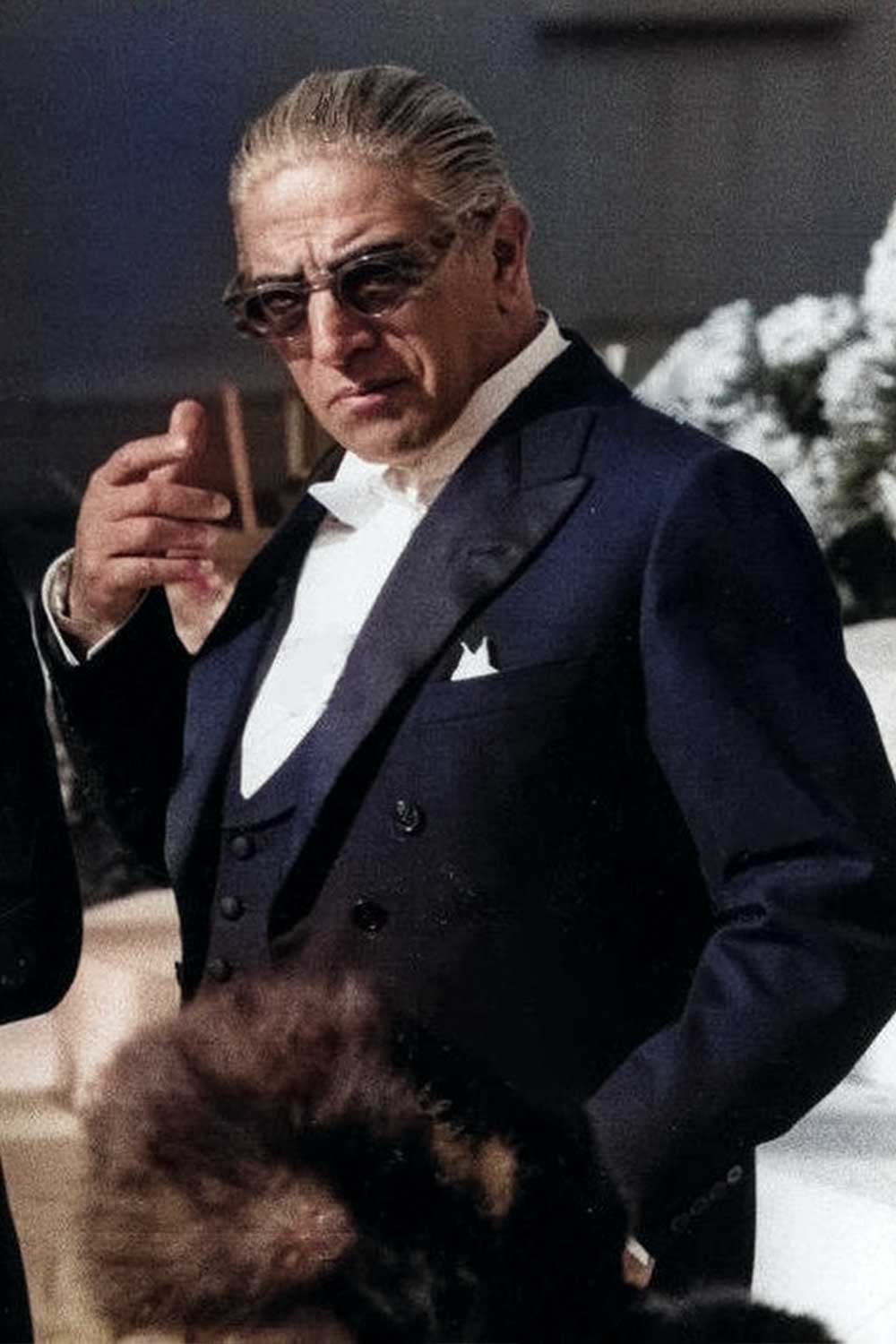
At the heart of Aristotle Onassis’s sartorial legacy lies a wardrobe built on impeccable tailoring, luxurious fabrics, and understated accessories that depict wealth and sophistication.
The cornerstone of his style was the bespoke double-breasted suit, meticulously crafted by the renowned Milanese tailor Caraceni.
Caraceni’s suits, in navy blue or charcoal grey worsted wool, featured wide peaked lapels, a nipped waist, and a slightly longer jacket that elegantly concealed Onassis’s compact 5’5″ frame.
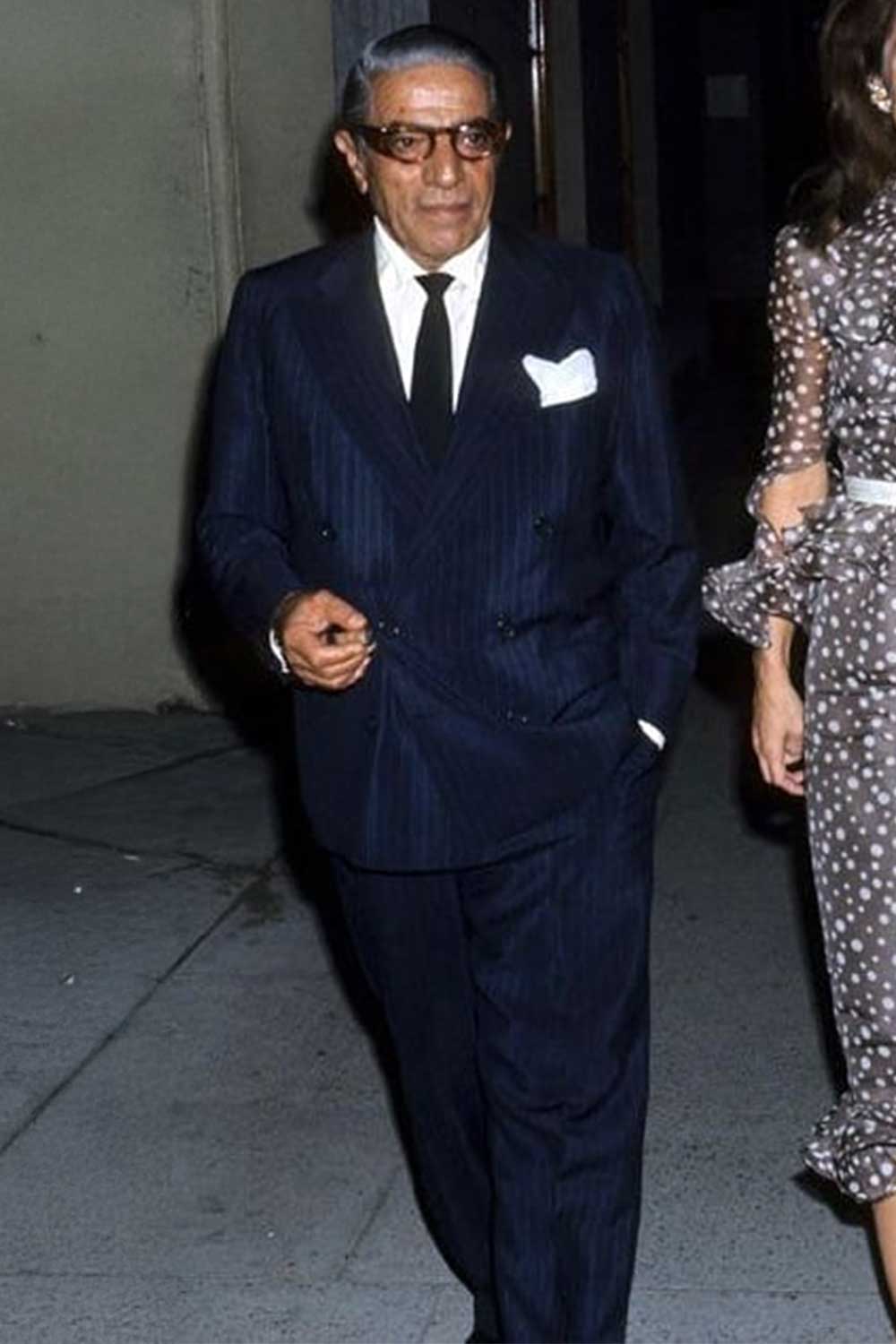
Complementing his suits, Onassis favoured perfectly pressed white shirts from Turnbull & Asser, worn with the collar open to project a relaxed confidence.
His neckwear of choice was the knitted silk tie, usually in solid navy or black, providing a subtle textural contrast to the smooth finish of his suit.
For footwear, Onassis relied on handcrafted black leather oxfords from London’s John Lobb, their sleek lines harmonising perfectly with his tailored trousers.
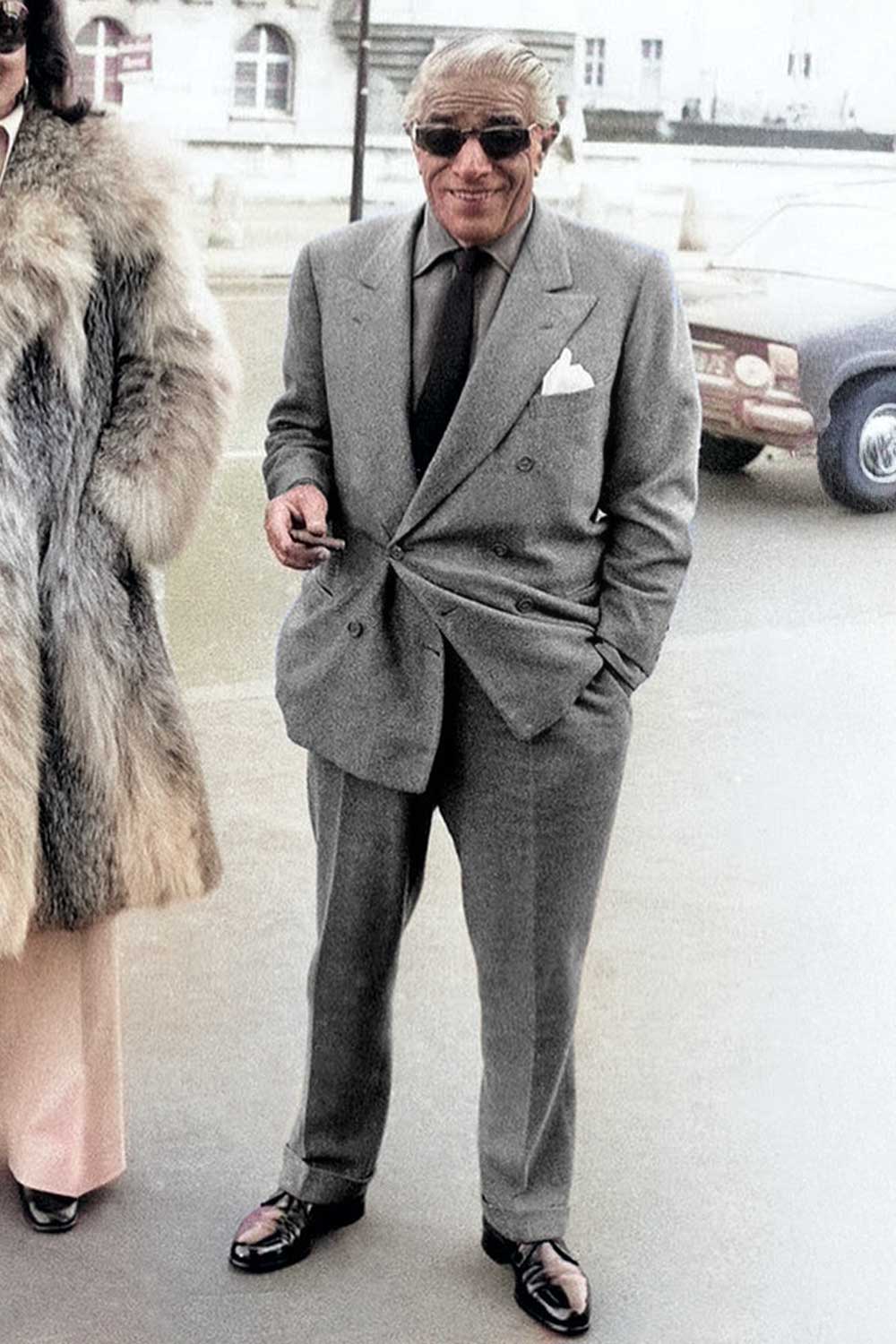
On the sun-drenched shores of the French Riviera, Onassis’s casual attire was no less considered, with lightweight linen trousers in pristine white and unbuttoned polo shirts in muted tones of ecru or light blue.
He paired the outfits with Gucci’s horsebit loafers – worn sockless for a touch of Mediterranean nonchalance – and thick-framed sunglasses custom-made by François Pinton, which became an iconic part of his image.
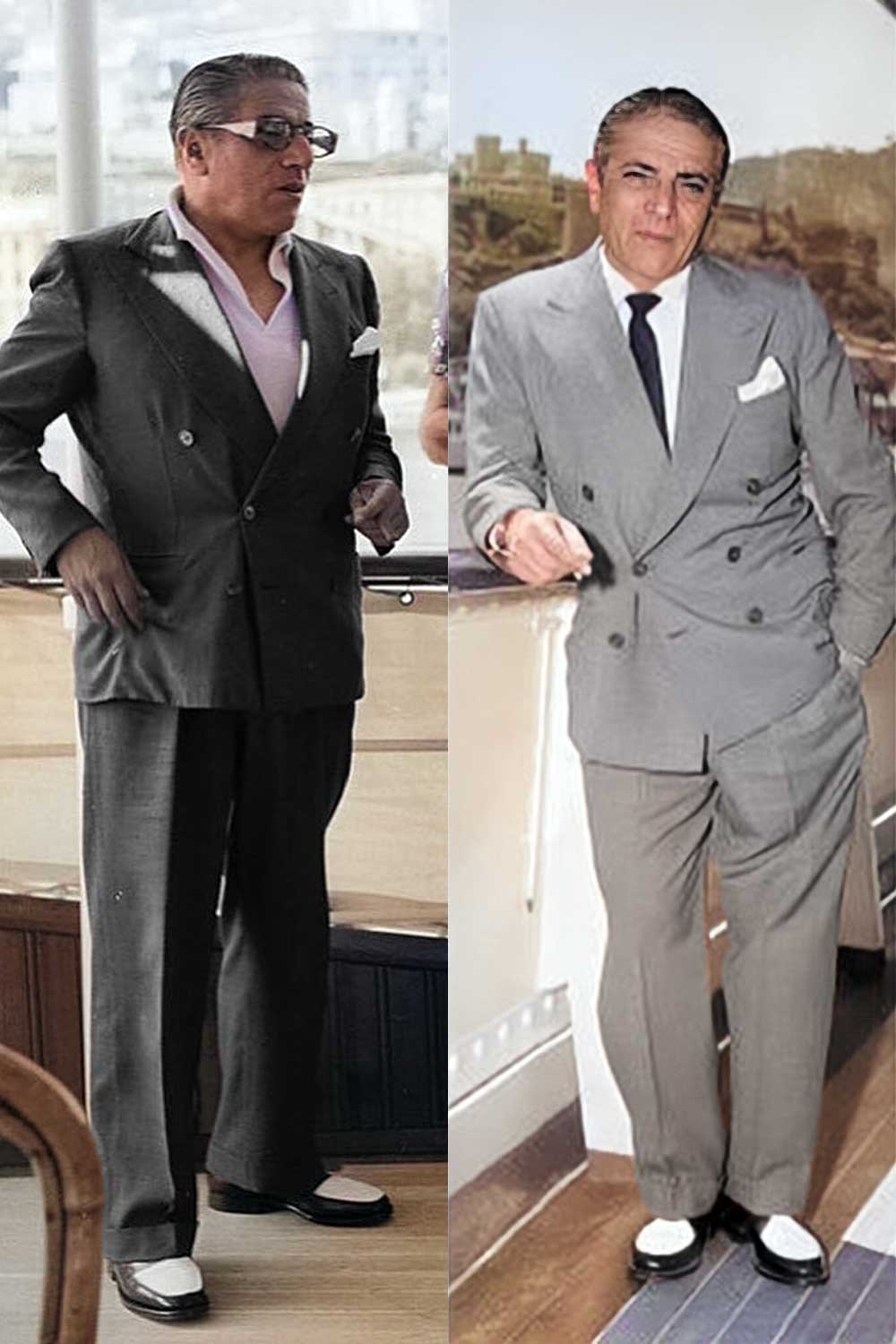
Whether in the boardroom or on his yacht, Onassis’s wrist invariably bore a Patek Philippe or Omega timepiece, their understated elegance as a subtle reminder of his discerning taste and immense wealth.
His dedication to sartorial excellence extended to every aspect of his appearance, from his meticulously groomed salt-and-pepper hair to the perfectly folded white linen pocket square that adorned his suit jacket.
Onassis’s Lifestyle
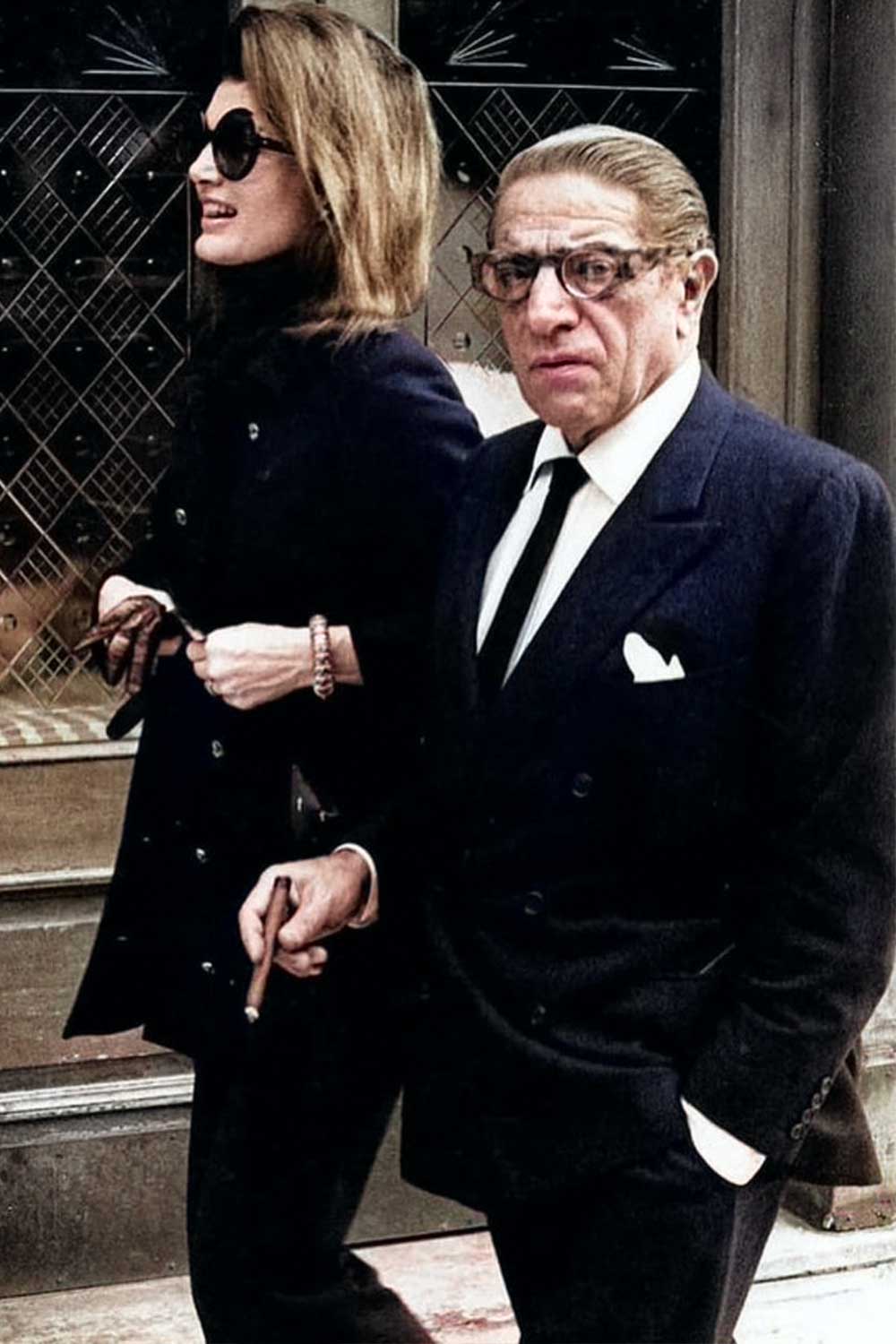
Aristotle Onassis’s style extended far beyond his clothing choices, encompassing a lifestyle that reinforced his image as the epitome of old-money elegance.
Understanding these aspects of his life provides a crucial context for fully appreciating and emulating his sartorial choices.
The Christina O
Central to Onassis’s image was his yacht, the Christina O. This 325-foot vessel, converted from a Canadian naval frigate, symbolised his wealth and taste.
The yacht’s interiors, designed by Cäsar Pinnau, featured traditional nautical elements and opulent touches.
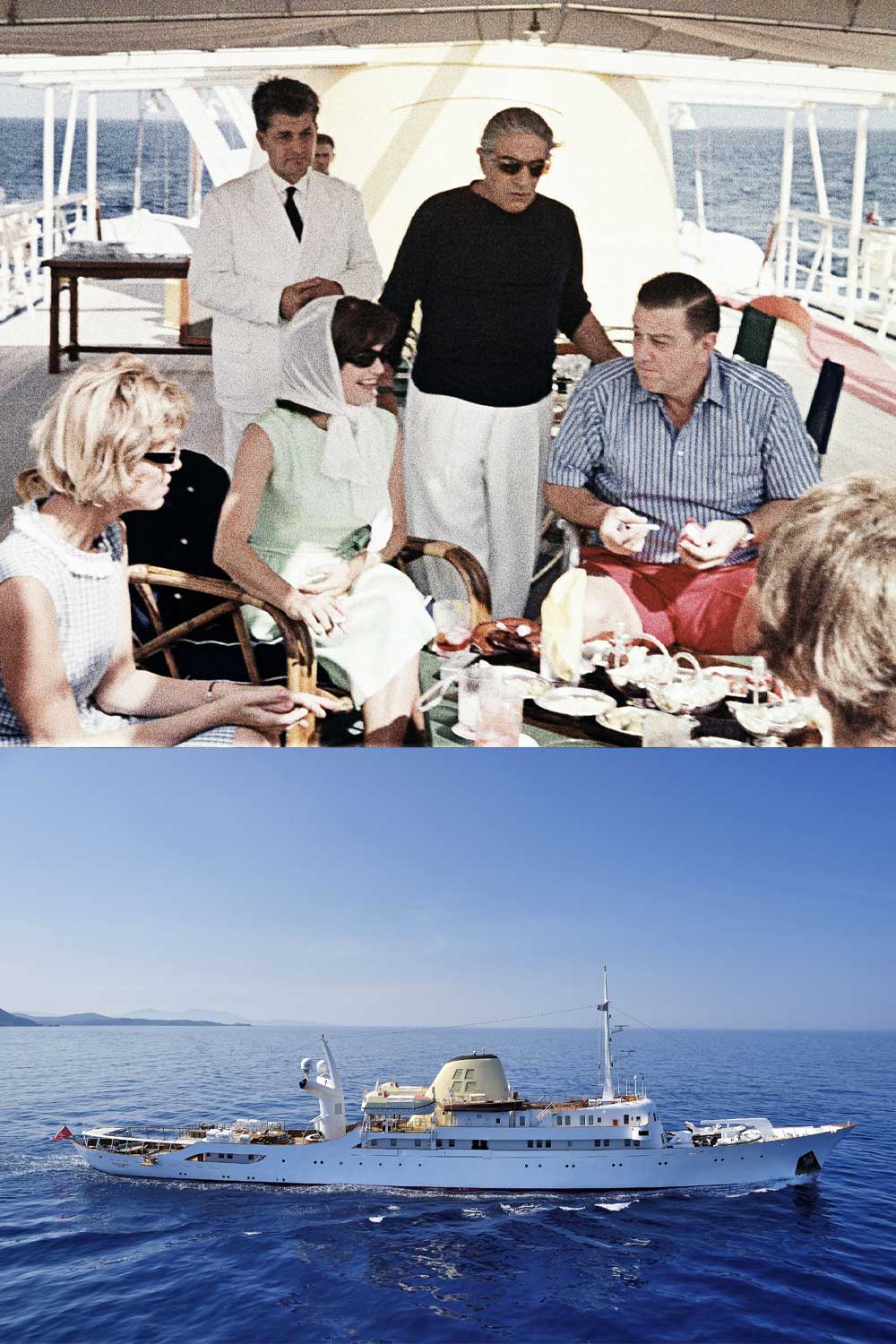
Onassis often entertained guests in the Lapis Lazuli Lounge, where the bar was topped with whale teeth and stools upholstered in fine leather from the foreskins of whales.
Onassis’ blends of traditional furniture with striking, exotic pieces adorned with luxurious elements mirrored his dressing style and unique sprezzatura touch.
Monte Carlo
Onassis’s influence extended to his adopted home of Monte Carlo.
As a major shareholder in the Société des Bains de Mer, which controlled the Monte Carlo Casino and the Hôtel de Paris, Onassis shaped the principality’s image as a playground for the wealthy.
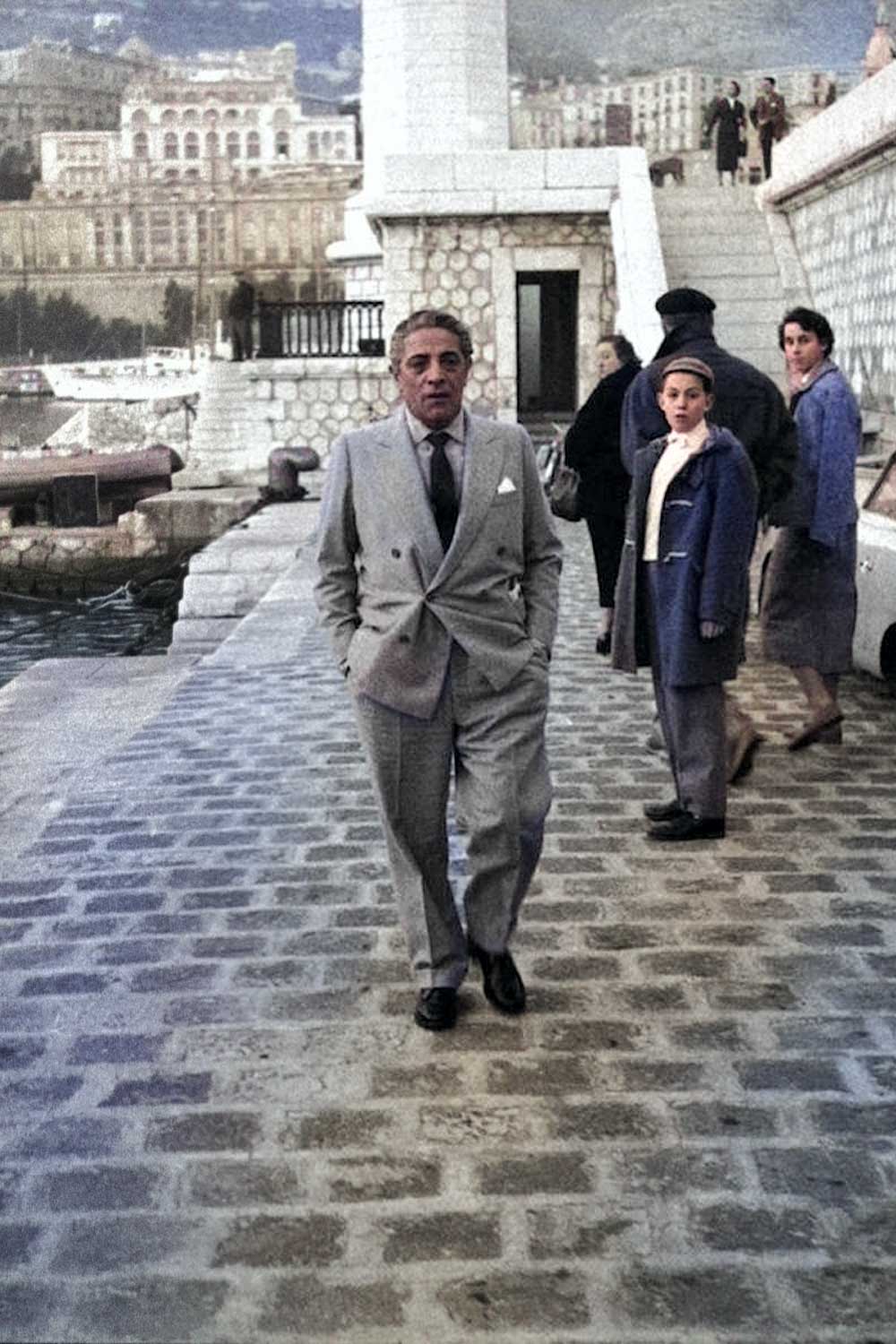
His regular appearances at the Casino, impeccably dressed in a midnight blue tuxedo with a black bow tie, set the standard for evening wear in the principality.
The Hôtel de Paris’s Bar Américain became his unofficial office, where he would conduct business deals over glasses of Johnnie Walker Black Label, his preferred scotch.
Social Circles and Relationships
Onassis’s romantic entanglements with some of the world’s most famous women further cemented his status as a style icon.
His relationship with opera diva Maria Callas saw him frequently photographed at the world’s most prestigious opera houses, always in impeccable black tie attire.
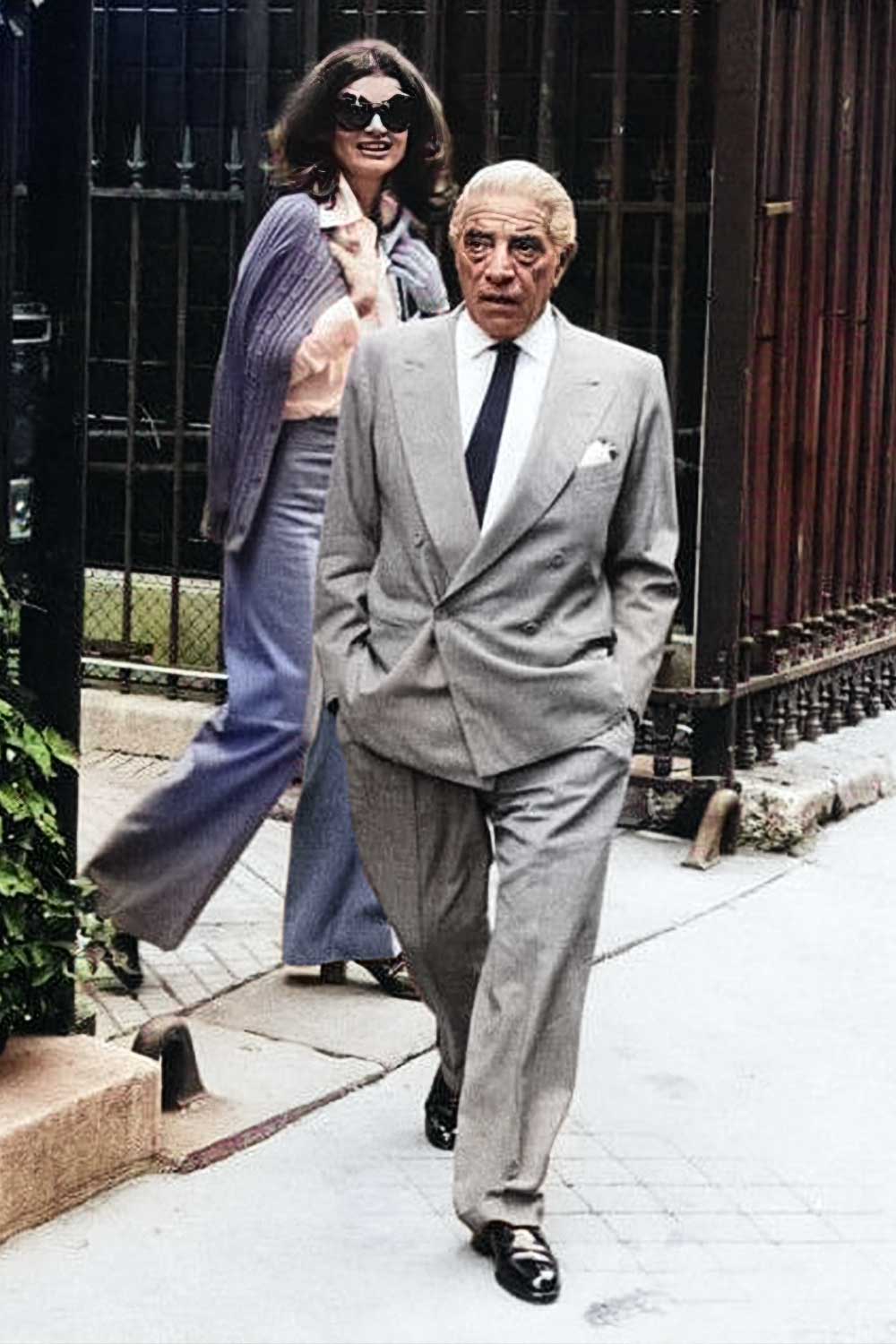
Later, his marriage to Jacqueline Kennedy brought him into the orbit of American political royalty, influencing his style to incorporate more elements of East Coast prep, such as the occasional rep tie or tailored blazer.
The Art of Leisure
Even in his leisure activities, Onassis maintained his commitment to style.
Whether playing backgammon on the deck of the Christina O or sunbathing on the beaches of Skorpios, his private island, the mogul was always perfectly dressed.
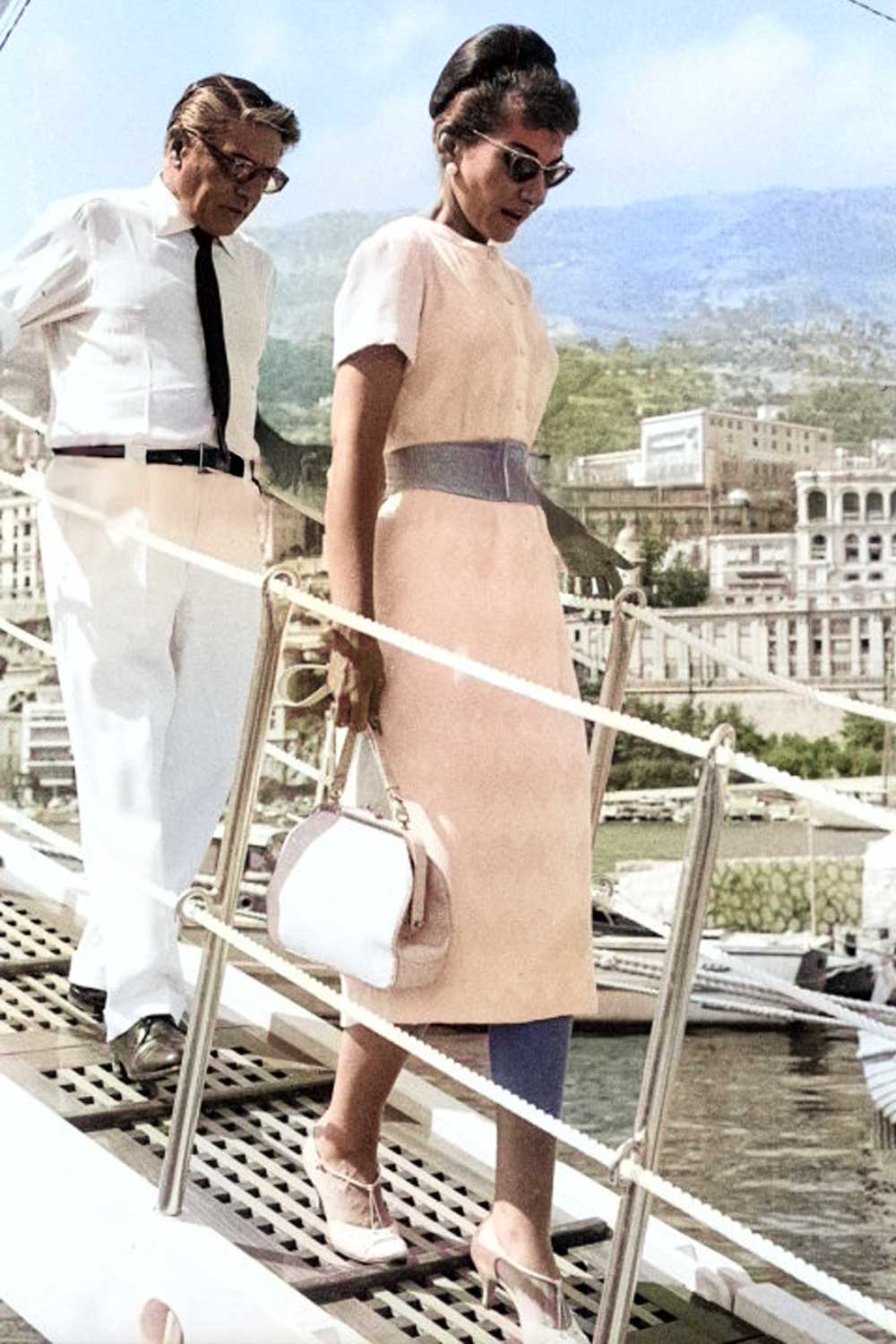
For beach wear, he favoured tailored swim trunks in navy or white, paired with a short-sleeved linen shirt left casually unbuttoned.
His beach accessories often included a pair of espadrilles and a finely woven straw Panama hat, demonstrating that elegance need not be sacrificed for comfort.
How to Dress Like Onassis
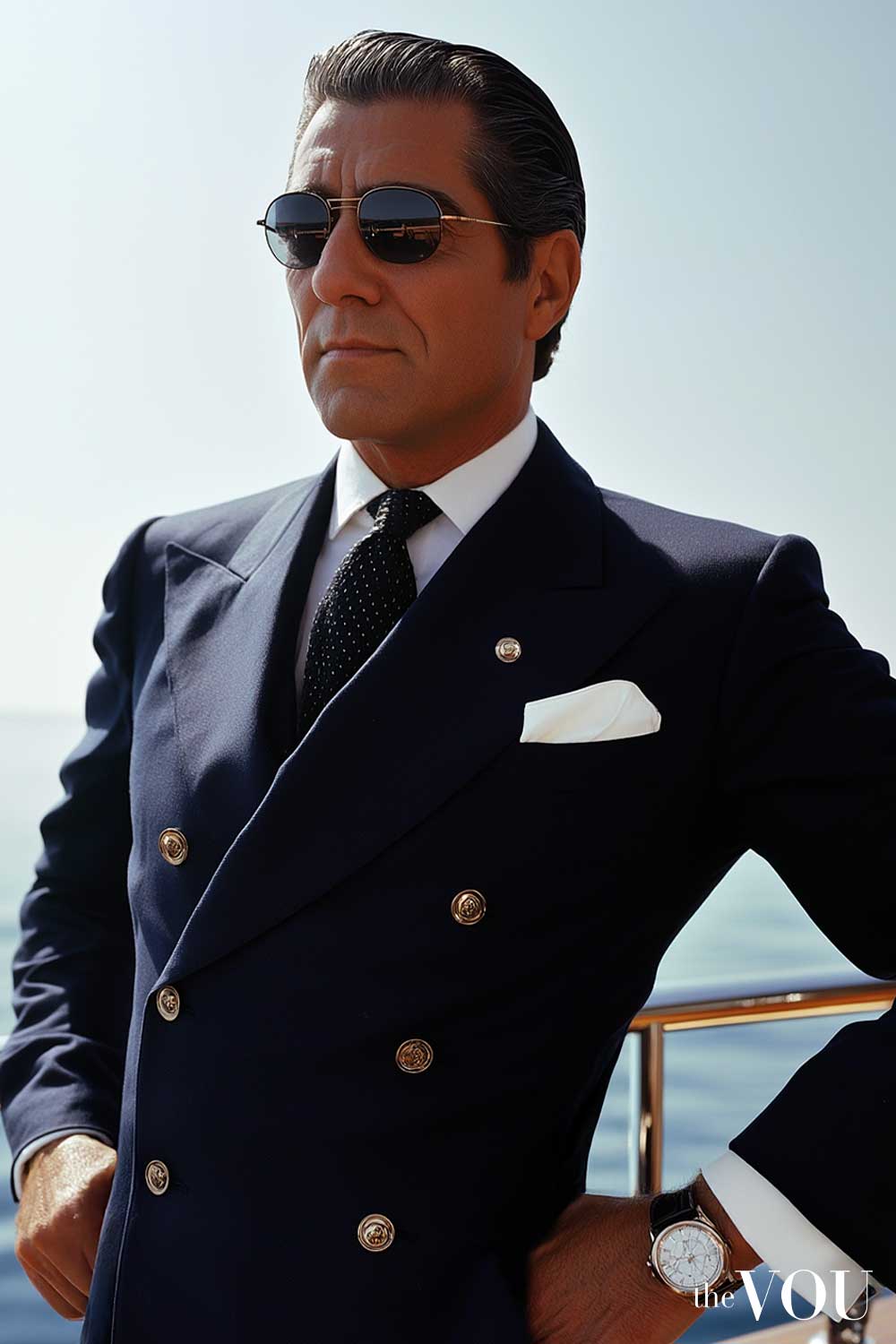
For formal occasions, emulate Onassis’s signature look with a navy blue double-breasted suit made from high-quality worsted wool.
Seek a skilled tailor to recreate the wide peaked lapels, suppressed waist, and slightly elongated jacket that defined Onassis’s Caraceni suits.
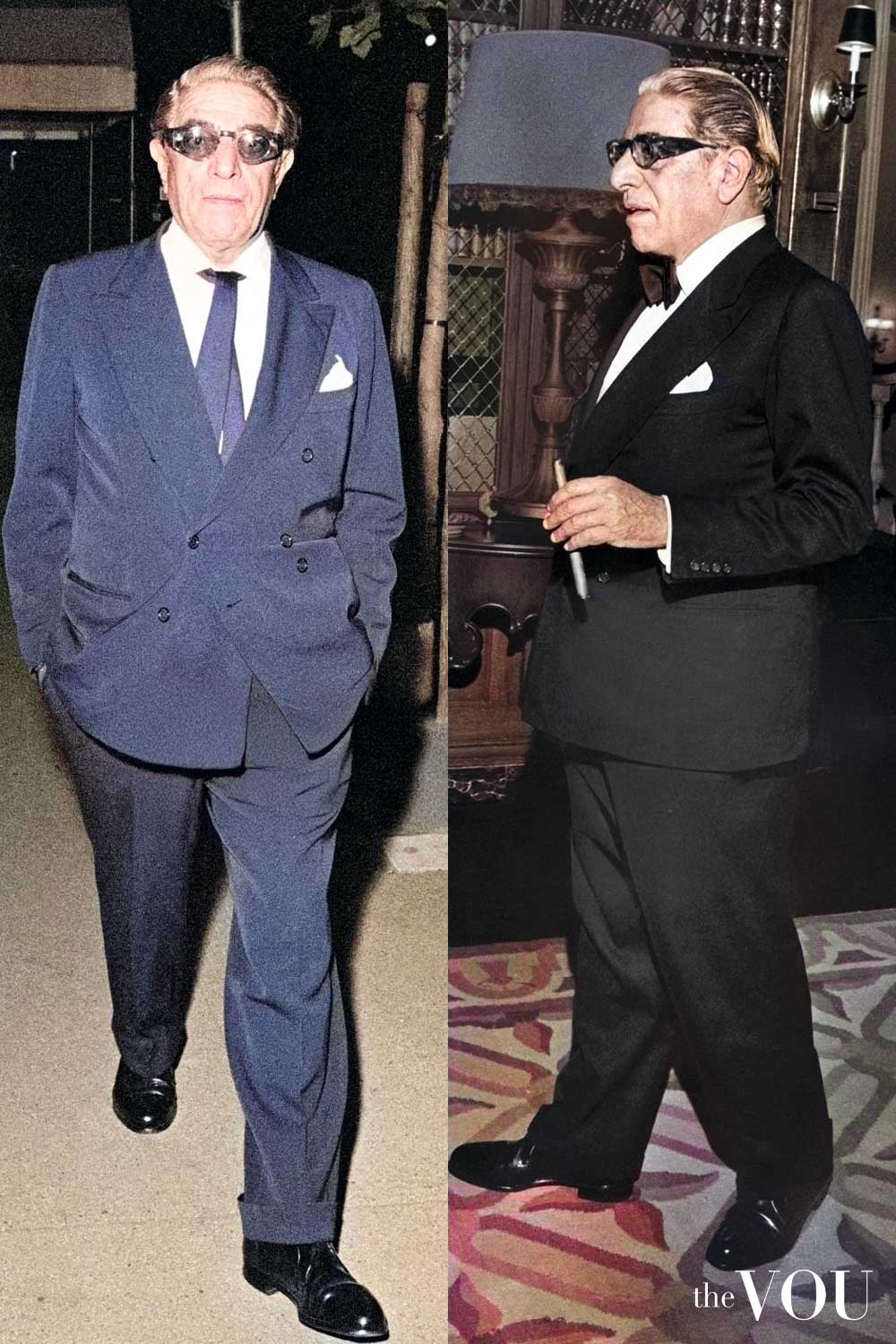
Pair this with a crisp white cotton dress shirt featuring a moderate spread collar from Turnbull & Asser.
Complete the ensemble with a knitted silk tie in solid navy or black, and finish the look with leather Oxford shoes from John Lobb.
For a relaxed Riviera-inspired look, choose well-cut white linen trousers paired with a polo shirt in neutral tones such as ecru or light blue.
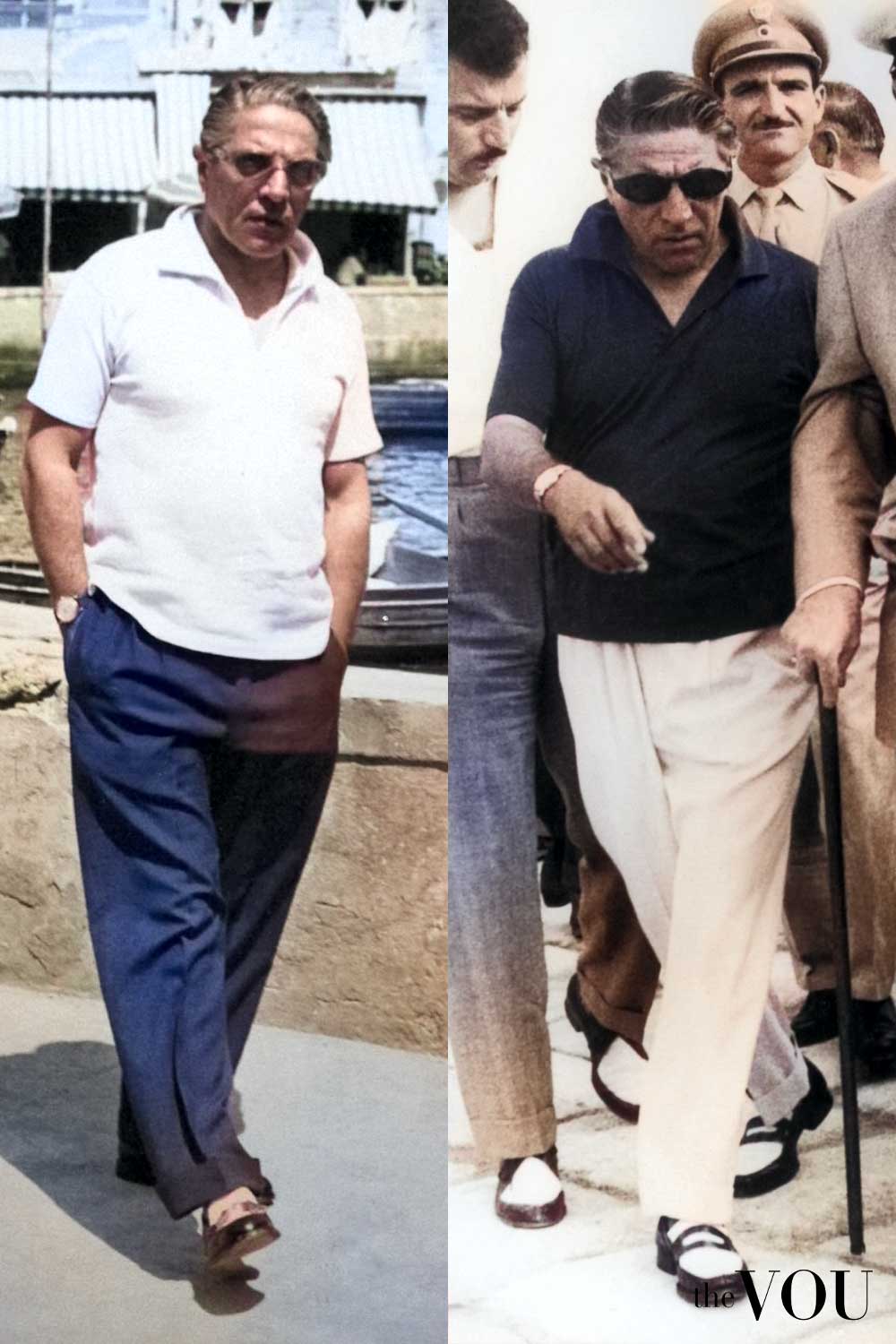
Brown leather horsebit loafers worn without socks capture Onassis’s effortless summer style.
Add a pair of bold, thick-framed sunglasses reminiscent of Onassis’s François Pinton originals to complete this casual yet refined outfit.
Final Thoughts – Onassis Style as a Powerful Tool for Influence
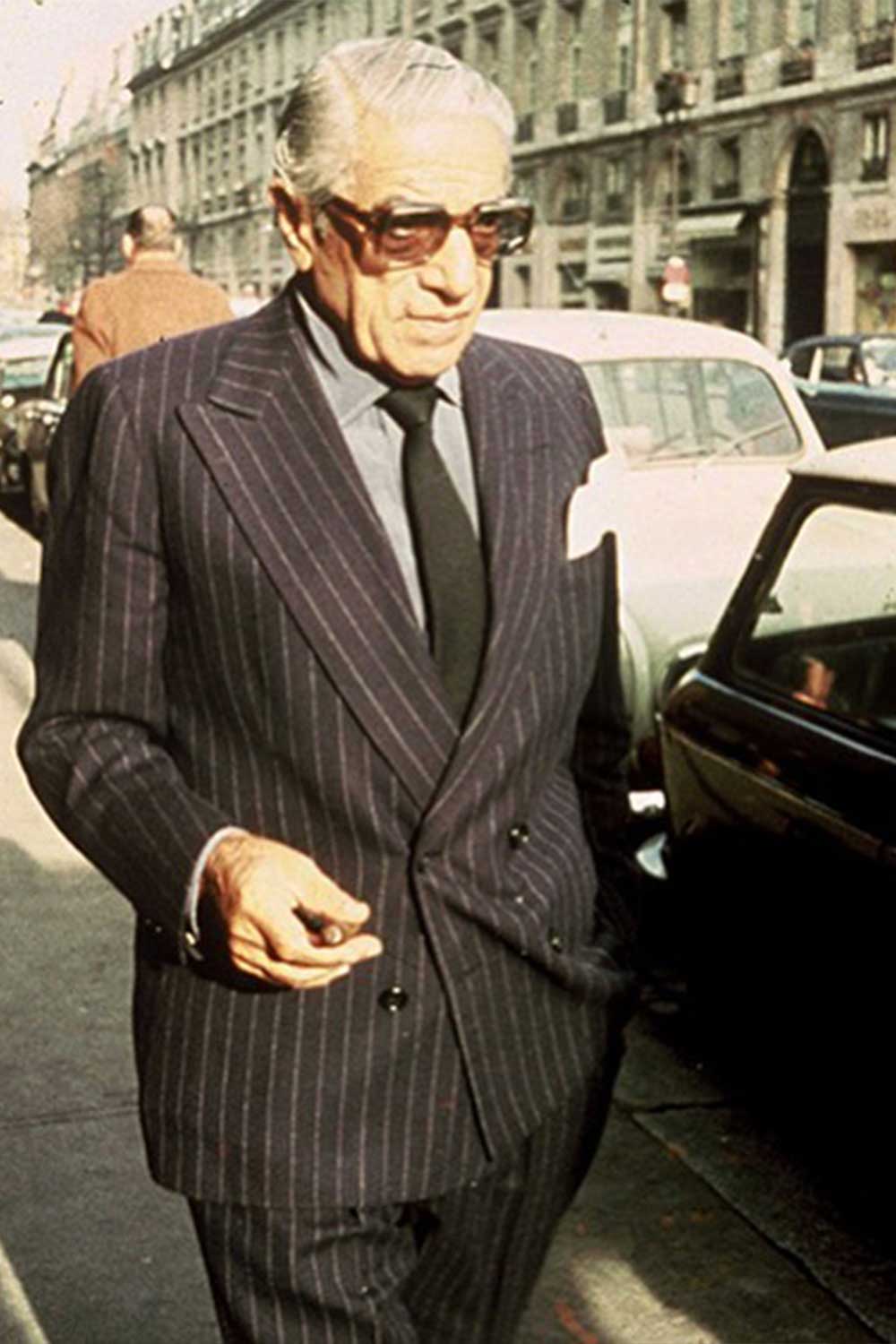
Aristotle Onassis’s style transcended mere clothing; it was a powerful tool for communication and influence.
His sartorial choices projected an image of unassailable success and quiet authority in every setting.
To truly embody the Onassis aesthetic, one must understand and apply the principles behind his wardrobe decisions.
The Double-Breasted Suit as Armour
Onassis’s preference for double-breasted suits was no accident, as the suits’ overlapping front panels and peaked lapels create an imposing silhouette that commands attention.
Onassis often left his suit jacket buttoned when entering a room, maintaining a sleek, unbroken line from shoulder to hip.
This practice flattered his physique and presented a fortified front to the world.
Old Money Colours
The shipping magnate’s colour palette was deliberate and refined.
Navy blue suits dominated his wardrobe, a colour choice that conveyed trustworthiness and authority.
For evening events, he often opted for a midnight blue tuxedo rather than traditional black, a subtle distinction that set him apart in dimly lit rooms.
His consistent use of white shirts created a stark, clean contrast that drew attention to his face, enhancing his presence in conversations and negotiations.
Accessorising Well
Onassis understood the power of subtle details; his François Pinton sunglasses with distinctive thick frames became a signature accessory that added an air of mystery and allure.
He wore them even indoors at times, using them as a tool to control his gaze and maintain a mysterious demeanour during high-stakes business dealings.
His choice of timepieces, alternating between a Patek Philippe Calatrava and an Omega De Ville, spoke of discerning taste without ostentation.
While undoubtedly expensive, these watches were chosen for their elegant simplicity rather than flashy complications.
Casual Power Dressing
Even in casual settings, Onassis maintained his aura of authority.
On his yacht, he favoured crisp white trousers paired with navy blue polo shirts, which echoed the colours of his formal wear while adapting to the nautical setting.
This consistency in colour choice across formal and casual wear created a cohesive personal brand that was immediately recognisable.
Style Like a True Gentleman
Before we say goodbye, here’s one of the best-kept secrets in men’s styling circles, a secret that only a few expert image consultants know or are willing to share.
First and foremost, professional styling requires knowing your unique body shape and seasonal colour palette – paramount factors in choosing perfectly fitting clothes in colours that complement your skin, eyes, and hair.
Only then can a stylist engage in styling by occasion, location, season, and time of day, with garments, footwear, and accessories from stylistically relevant heritage fashion brands to depict high confidence and success.
Best part? You can find your body shape, seasonal colour palette, and ideal fashion style in less than 5 minutes by yourself, for free, thanks to our four simple steps:
1. Find Your Body Shape
Different garments flatter different silhouettes, so knowing your body shape is the first step in dressing like a confident man.
To find out your unique body shape, take our free body shape quiz for men.
Once you know your unique body shape, take the second free quiz to discover your unique colour palette.
2. Find Your Unique Colour Palette
Remember, the garments that compose your outfits come in various colours, and you must ensure that each hue complements your natural colour.
To do that, you have to find out your seasonal colour palette, and you can do it by taking our free seasonal colour quiz for men.
3. Find Your Ideal Fashion Style
By now, you should already know your body shape and unique colour palette; the next step is to discover your ideal personal fashion style.
The fastest and simplest way is to take our free fashion style quiz for men; it includes your ideal style, outfit ideas, relevant fashion brands, and much more.
4. Professional Image Consultancy with The VOU
And if you want to style like a professional, by occasion, location, season, and time of the day, you can always ask our expert image consultants and fashion stylists for help.
Our styling services for men are the most comprehensive and detailed on the market, backed up by leading stylists who will guide you step by step in creating looks that communicate affluence, elegance, and endless accomplishments.
Remember, wearing luxury brands isn’t enough; to look stylish, confident, and successful, you must first know your body shape, colour palette, and ideal personal style, and only then style by occasion, location, season, and time of day.
Contact us today to save headaches, time, and money – it’s time to dress like a confident, successful gentleman of exquisite fashion taste – the first styling assessment is on us!
A passionate advocate for inclusivity and diversity, Aidan is the driving force behind The VOU as its Editorial Manager. With a unique blend of editorial acumen and project management prowess, Aidan's insightful articles have graced the pages of The Verge, WWD, Forbes, and WTVOX, reflecting his deep interest in the dynamic intersection of styling with grooming for men and beyond.
With years of expertise in high-end fashion collabs and a PhD in Sustainable Fashion, Ru specialises in eco-luxe wardrobes for the modern gentleman seeking understated refinement.
After years of managing hundreds of fashion brands from London's office of a global retailer, Mandy has ventured into freelancing. Connected with several fashion retailers and media platforms in the US, Australia, and the UK, Mandy uses her expertise to consult for emerging fashion brands create top-notch content as an editorial strategist for several online publications.
With over twenty years of front-row fashion and styling events, collabs with haute-couture houses, and a PhD in Luxury Fashion, Laurenti is an expert in crafting personalised looks that depict old-money sophistication.


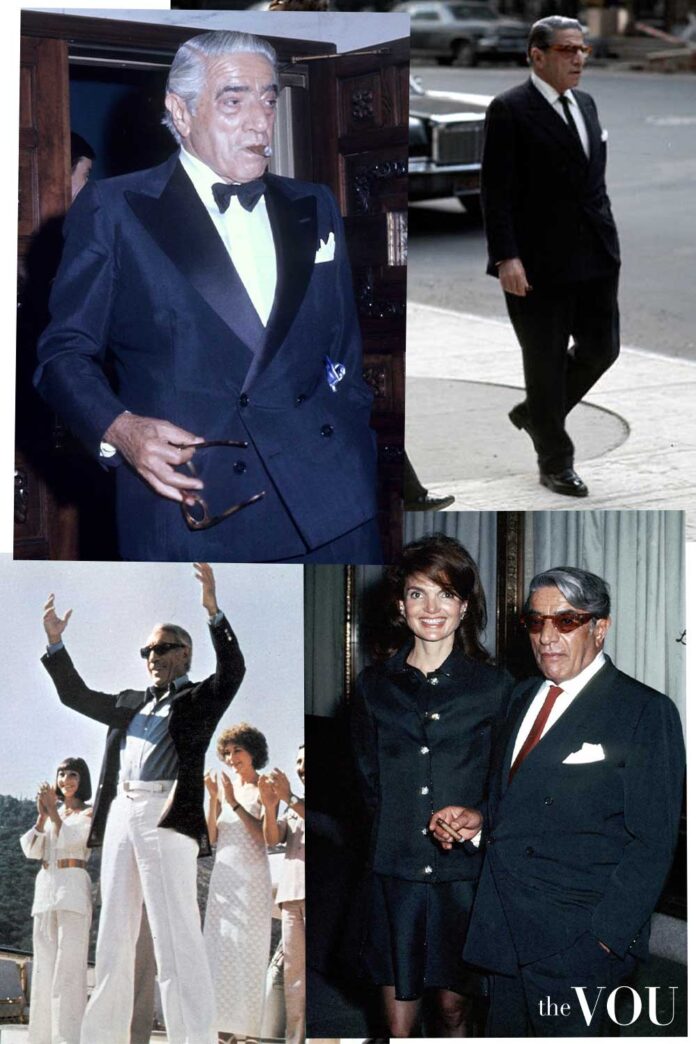
Your article contains very useful and meticulous information about fashion and style. Your article is very enlightening, thank you for that. However, I would like to correct a mistake. Izmir was in the Ottoman lands for 600 years. It was occupied by the Greek army in 1919. It was taken back by the Turks who has already entered the liberation war in 1922. Unfortunately, the Greek citizens living in Izmir had to leave due to the conditions of the period. However, Izmir was not destroyed by the Turks. Please correct this mistake.